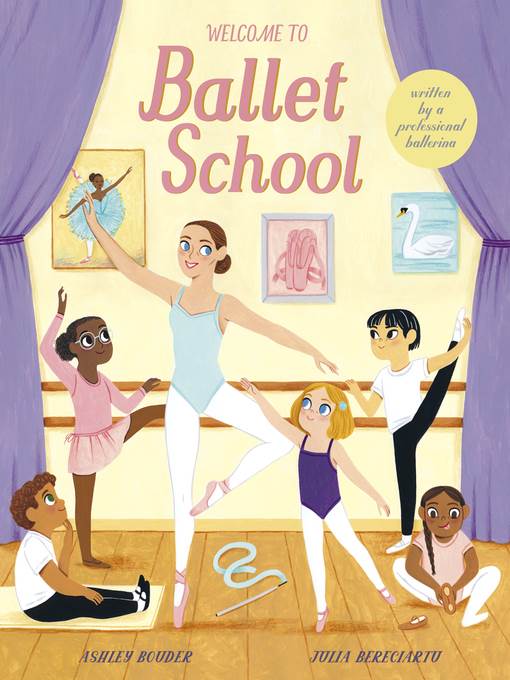
Welcome to Ballet School
کتاب های مرتبط
- اطلاعات
- نقد و بررسی
- دیدگاه کاربران
نقد و بررسی

June 29, 2020
Bouder, a principal dancer with the New York City Ballet, offers a kid-friendly introduction to ballet in this simplistic depiction of five children’s first experiences of class. “No matter what you look like, ballet is for everyone” Bouder announces in an introductory note; though the mixed-gender group appears culturally and ethnically diverse, no other differences are apparent. Gouache and colored pencil cartoon illustrations by Bereciartu (High-Five to the Hero) enhance the book’s welcoming tone as a kindly teacher (who outdatedly addresses the school-age children as “little ones”) shepherds them quickly from warm-ups and the five basic positions to arabesques and pirouettes to performing a classical ballet. Exceptionally helpful for beginners, close-up diagrams show ballet’s five positions (separate spreads cover arms and legs) and detail each stage of the legs’ movements in traditional ballet steps (plié, tendu, etc.). Bouder strikes several personal notes, for example appearing as the ballerina-mother of a student who bears her own daughter’s name, guiding the classmates through a performance of Sleeping Beauty. Though readers won’t take away a sense of ballet’s rigor or artistic resonance (these dancers choose what to wear, what positions to try, and which roles they want to enact), the book is a useful and appealing primer for those with little to no experience in the ballet studio. A glossary and ethnically inclusive gallery of important dancers concludes. Ages 4–7.

June 1, 2020
K-Gr 3-A group of children arrive at the ballet studio ready to learn. They warm up, practice the moves from Sleeping Beauty, and conclude with a lesson on the importance of bowing to the audience. Bouder, a principal dancer with the New York City Ballet, provides a thorough introductory, interactive guide for novice ballerinas. Each page is broken into sections, showing the students demonstrating moves with arrows for direction. There are also definitions of ballet terms, with illustrated close-ups of hands and feet. Some readers may have trouble with the pronunciation of some terms, as there is not a phonetic guide, but the images will allow readers to follow the moves with ease. The children in the book include male and female students, as well as kids from different ethnic and racial backgrounds. The faces of the children in the class showcase a range of emotions and feelings (hesitation, concentration, worry), reminding young readers that any skill or activity takes practice. VERDICT A detailed and practical title for those interested in learning about ballet or to engage young readers in movement during story time.-Kaitlin Malixi, Kensington Health Sciences Academy, Philadelphia
Copyright 2020 School Library Journal, LLC Used with permission.

June 15, 2020
Read! Practice! Perform! Three girls (Amirah, Violet, and Sahani) and two boys (Joonwon and Alejandro) take ballet class. They clearly demonstrate warm-up moves, basic feet and arm positions executed at the barre, and center-floor movements including jumps. Their facial expressions vary from happy to fretful. When they have performed their "reverence," or bows, they are ready to move on to a performance of The Sleeping Beauty, a popular story ballet danced to a beautiful score by Tchaikovsky. Violet's mom, a former dancer, enters to tell the children the story, and they act out the various roles, from the elegant Lilac Fairy to the evil Carabosse. Each role involves steps that they previously learned and very expressive facial and body emoting. Bouder is a principal dancer with the New York City Ballet and writes with enthusiasm and knowledge. The uncluttered cartoon illustrations are lively and colorfully detailed, depicting a multiracial cast (as hinted at by the children's names). That Violet and her ex-professional mom are white somewhat undermines the egalitarian message. While it may prove challenging for readers to actually try the steps on their own, especially the jumps, they should enjoy practicing. When readers play the score (not included but readily available) in the background, correct ballet movement or simply expressive individual movements can result in a very enjoyable staging. The many enchanting elements of dance and story in The Sleeping Beauty ballet come alive for young children. (glossary) (Picture book. 5-8)
COPYRIGHT(2020) Kirkus Reviews, ALL RIGHTS RESERVED.

October 15, 2020
Grades K-3 In this instructive, inviting primer, professional ballerina Bouder shares a dance that's for everyone: ballet. On the first day of ballet school, a diverse group of aspiring dancers (including, refreshingly, a couple of boys) meet their teacher, Ms. Marcia, to learn essential warm-ups, arm and leg positions, and basic ballet steps. Once the lesson is over, a former student of Ms. Marcia's guides the children through a rehearsal of the choreography of Sleeping Beauty, and their practice culminates in a performance shared with their loved ones. The lively artwork in bright tones does a good job of highlighting both basic ballet positions and the movements required for individual steps and techniques, such as coup�, pass�, attitude, frapp�. The beginning pages are very instructional, with illustrations bordering on diagrams, while the choreography practice portion nicely demonstrates how ballet can tell stories. A closing collage of an inclusive array of working professional dancers will be inspiring for little ones, and a glossary helps define terms even further. Kids eager to learn ballet will be well served by this introduction.(Reprinted with permission of Booklist, copyright 2020, American Library Association.)

























دیدگاه کاربران